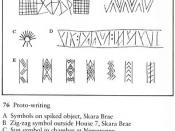Artefacts and ecofacts are two common terms one will hear associated with archaeology. When excavating a site these two things are hoped and expected to be discovered, but what are they and how do they fit in with archaeology? Unless properly preserved, artefacts are likely to decay, be destroyed or simply fade as the centuries fly by. This makes an archaeologists mission in piecing together the mystery of the past even harder. From the tiny clues that they are able to obtain they must attempt to learn more and research into what is left of the past. But how does an archaeologist uncover these artefacts or ecofacts? What is process that must be undertaken?
During an archaeological excavation, three things are aimed to be discovered, artefacts, ecofacts and features. In an archaeological sense, an artefact is a portable item that was made, used, modified or transported by humans that gives us information about human behaviour in the past.
Portable is a key term as man-made objects such as buildings are defined as features. Fagans description is objects found in archaeological sites that exhibit attributes resulting from human activity. (Fagan M. 2012) Artefacts can be anything made or used by humans including but not limited to tools, containers, manufacturing debris and food remains (Kipfer B. 2007). In contrast to the man made or used object of an artefact, an ecofact is a naturally formed object, unmodified by humans that gives us information about environments in the past. Plant or animal remains are a prime example of ecofacts. (Reitz E. Shackley M. 2012) describe ecofacts as any biological or geological evidence, presuming that it is something made by nature rather than by people.
Artefacts are the tangible remains of our ancestors and awareness of them and their importance is beneï¬Âcial to a...


